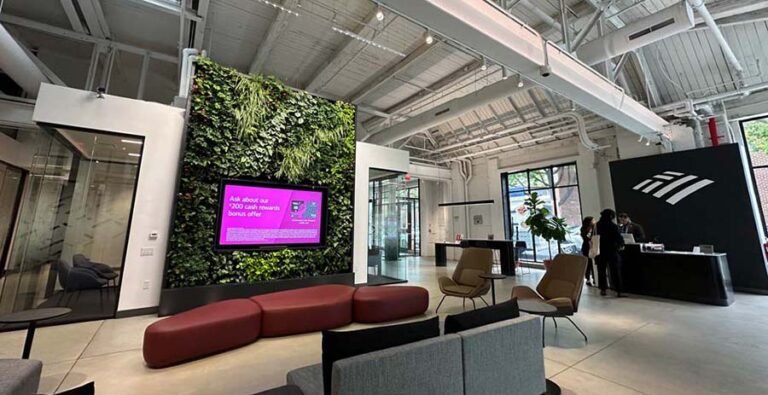NEW YORK — It’s like Sephora and Starbucks now offering checking accounts.
After years of closing or largely ignoring bank branches across the U.S., the nation’s largest banks are spending hundreds of millions of dollars to renovate old branches and build new ones, changing the look, feel and purpose of local bank branches in the process.
Many of these branches are larger and more open, making people who stop by with tough financial questions feel more comfortable. Others are designed as “third spaces” to allow local nonprofits and community representatives to hold workshops and seminars for customers and neighbors. They stand in stark contrast to the marble-clad financial temples built 50 or 75 years ago and the hackneyed, one-size-fits-all branches that crowd suburban shopping malls these days.
“Going into a branch can be intimidating, and we’re creating spaces right now where everyone feels welcome,” said Diedra Porche, head of community and business development for JPMorgan Chase’s consumer banking division.
Porcher leads a team of 150 employees who work in what JPMorgan now calls “community centers” — larger branch offices with space for nonprofits to give presentations to local residents and offer workshops to those seeking advice. The newest of these community centers opened in the Bronx in April and was attended by local and state New York politicians, as well as JPMorgan Chairman and CEO Jamie Dimon.
JPMorgan isn’t the only bank designing branches with a focus on advice over sales: Capital One opened its newest “cafe” in Union Square in May, serving coffee and baked goods and allowing anyone, even those who aren’t Capital One customers, to work and socialize inside.
“Banking shouldn’t be about someone in a suit sitting behind a desk talking to you about applying for a loan, it should be about someone sitting next to you and helping you answer your questions about money and finances,” said Jennifer Windbeck, head of consumer banking channels and operations at Capital One.
Banks including JPMorgan Chase, Bank of America, and Wells Fargo have been closing branches one after another since the financial crisis of 2008. With fewer Americans regularly visiting branches for everyday banking, and with ATMs replacing tellers, banks decided there was little need for a network of thousands of physical branches. In the branches that remained, customers often found worn carpeting, worn office furniture, and cubicles.
Advances in technology during the pandemic that allow people to buy a home or a car without physical contact with another human being seemed to seal the fate of bank branches: The U.S. banking industry estimates it has closed roughly 4,000 branches since 2020, according to the National Community Reinvestment Coalition.
Policymakers and community advocacy groups criticized the banking industry for closing so many branches after the financial crisis, especially in low-income neighborhoods where financial services were limited to storefront check-cashing outlets, pawn shops and payday loans.
“When a bank branch closes, it has several negative effects on the surrounding area: reduced local small business lending and activity; increased use of alternative financial services that expose people to unregulated and predatory financial practices; and loss of important commercial tenants and employers,” NCRC researchers wrote in a 2020 report on the wave of bank branch closures.
Local bank branches are so important that during the Civil Rights era, Congress even got involved in the issue, passing the Community Reinvestment Act, which was aimed in part at ensuring that banks had branches in poorer areas as well as wealthier ones.
The trend of branch closures may be reversing, or at least slowing. Chase has added net new branches, while Bank of America has significantly reduced its branch closure rate. Other big banks, including Capital One and Wells Fargo, are also gradually adding more branches. Banks are finding new uses for branches, often in unexpected ways.
Despite the prevalence of digital banking, bankers and community groups stress that physical branches remain essential: When it comes to big financial matters, like buying a home or a car, preparing for retirement, dealing with the financial impact of marriage or divorce, or having children, Americans still prefer to visit a branch, according to industry and independent surveys.
Some banks are building new branches in unique locations that might not seem like a typical banking location at first glance.
For example, Bank of America hired Rebecca Sigfrids from Sephora and Victoria’s Secret as its branch’s first in-house designer, instead of using a traditional third-party contractor.
One example of Sigfries’ work is a Bank of America branch in Williamsburg, Brooklyn, that was previously used as a studio space for sculptors. The clean, airy branch features sculptures by artists who previously occupied the space, as well as artwork from the neighborhood.
“We’re really thinking about how to integrate this branch into the community. Bank of America has its own look and feel, but what if we were in Williamsburg? What if we were in downtown Manhattan or Seattle or Texas?”
JPMorgan Chase has opened nearly 20 what it now calls “community centers” — larger branches in low- and moderate-income neighborhoods aimed at providing more comprehensive services to Chase customers, who typically have lower incomes.
Chase is building a center with a multi-purpose area so that nonprofits and Chase employees, called community managers, can host workshops and financial education seminars for the community. Chase employees are specifically instructed not to talk about Chase products as part of the workshops to provide a higher level of trust, Porcher said.
“We wanted to expand into a space that would fulfill all the traditional needs of a branch but also allow customers to receive financial workshops and programming. [new branches] It should be a community anchor,” she said.


